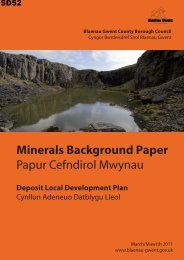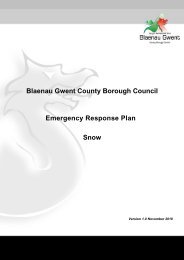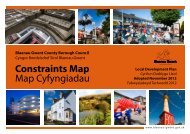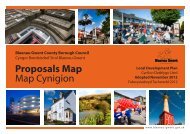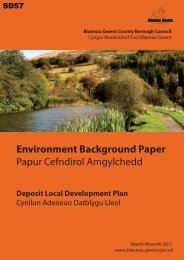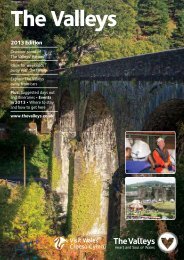Planning Policy Wales - Brecon Beacons National Park
Planning Policy Wales - Brecon Beacons National Park
Planning Policy Wales - Brecon Beacons National Park
Create successful ePaper yourself
Turn your PDF publications into a flip-book with our unique Google optimized e-Paper software.
eing required. That judgement must be taken on the particular merits of each case. Local planning<br />
authorities should consult CCW if uncertain about the significance of a project’s likely effect on the<br />
environment.<br />
5.5.10 The Welsh Ministers, on the advice of CCW, will normally call in, for their own<br />
determination, planning applications which are likely to have a significant effect on sites of more<br />
than local importance, for example, SSSIs, SPAs, candidate or designated SACs and sites listed<br />
under the Ramsar Convention 33 .<br />
Protected species<br />
5.5.11 The presence of a species protected under European or UK legislation is a material<br />
consideration when a local planning authority is considering a development proposal which, if<br />
carried out, would be likely to result in disturbance or harm to the species or its habitat 34 35 36 .<br />
Local planning authorities should advise anyone submitting a planning application that they must<br />
conform with any statutory species protection provisions affecting the site concerned, and should<br />
consult CCW before granting permission. An ecological survey to confirm whether a protected<br />
species is present and an assessment of the likely impact of the development on a protected species<br />
may be required in order to inform the planning decision.<br />
5.5.12 Developments are always subject to the legislation covering European protected species 37<br />
regardless of whether or not they are within a designated site. New developments for which<br />
development works would contravene the protection afforded to European protected species require<br />
derogations from the provisions of the Habitats Directive. A derogation 38 may only be authorised<br />
if there is no satisfactory alternative and if the action authorised will not be detrimental to the<br />
maintenance of the population of the species concerned at a favourable conservation status in its<br />
natural range. The development works to be authorised must be for the purposes of preserving<br />
‘public health or safety, or for other imperative reasons of overriding public interest, including<br />
those of a social or economic nature and beneficial consequences of primary importance for<br />
the environment’ 39 . Derogations are granted by a licence issued by the Assembly Government 40 .<br />
Local planning authorities are under a duty to have regard to the requirements of the Habitats<br />
Directive in exercising their functions. To avoid developments with planning permission subsequently<br />
not being granted derogations in relation to European protected species, planning authorities should<br />
take the above three requirements for derogation into account when considering development<br />
proposals where a European protected species is present.<br />
Trees and woods 41<br />
5.5.13 Local authorities have a duty to ensure that adequate provision is made for the planting or<br />
preservation of trees by imposing conditions when granting planning permission and/or by making<br />
Tree Preservation Orders (TPOs).<br />
5.5.14 Local authorities have a general power to make TPOs if it appears it is expedient to do so in<br />
the interests of amenity. They can make a provisional TPO which takes effect immediately, and it can<br />
remain effective for six months or until the TPO is confirmed.<br />
76<br />
<strong>Planning</strong> <strong>Policy</strong> <strong>Wales</strong> Edition 3 - July 2010 - Chapter 5 Conserving and Improving<br />
Natural Hertiage and the Coast


